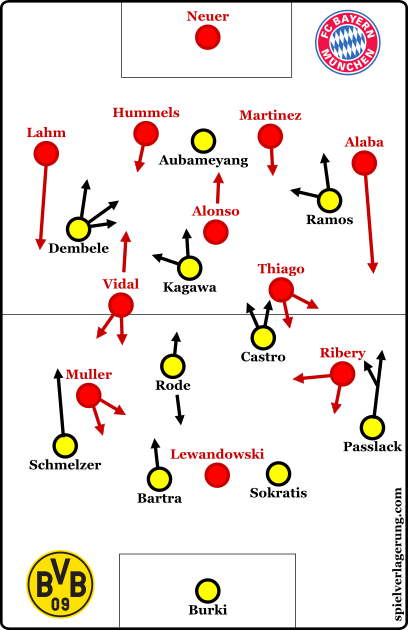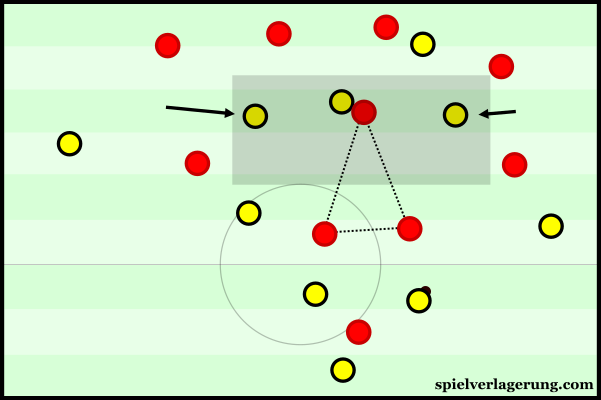Ancelotti debuts for Bayern in Super Cup win at Dortmund
Bayern and Dortmund met for their first competitive match of the new season, with Tuchel’s side playing host in the Super Cup. With both teams undergoing quite significant changes over the summer, it was an interesting spectacle to get a glimpse of how the two sides may play over the new 2016/17 season.
For Bayern, this was their first meaningful match without manager Pep Guardiola. The Catalan coach had made significant changes to the team over the past three years with a unique playing style which Ancelotti is unlikely to maintain.
From the perspective of the hosts, they have undergone a change not in manager but in player personnel. Losing their 3 most important players of last season and replacing them with 8 new signings, the match was a chance to see these new players in action and how such additions may impact the footballing style of Dortmund.
Bayern are no longer a Guardiola team
In Bayern’s first competitive match of the season, it was clear to see that this was no longer a team managed by Pep Guardiola. With the coach now applying his trade in Manchester and Carlo Ancelotti employed as his replacement, there were some significant differences in Bayern’s play compared to how we saw them over the 3 years with Pep. No longer playing under the concept of positional play, the differences in Bayern’s play with the ball were the most contrasting as their positional structure and ball circulation was something rarely seen over the last 3 seasons.
The first suggestion that Pep no longer occupied the dugout came an hour before the kick-off in the team sheets. Bayern’s line-up hinted at a much more orthodox formation and that is exactly what we got. David Alaba, a player who had taken on many roles under Guardiola, returned to his left-back position in a 4-1-4-1 shape which sprung no surprises. Although given some positional freedom (as a team with such players almost requires), the dynamics of the shape were also nothing out of the ordinary.
With regards to their spacing, Bayern’s positional structure was unsurprisingly much less consistent without such a focus on occupying the midfield so strongly. Although they were able to form basic structures and triangles for the ball-carrier, they were unable to expand from this and develop small combinations into larger plays to move the ball into space. The support structures for the ball-carrier weren’t sufficient to allow progressive ball circulation and their passing was much less clean as a result.
Playing off-of-the-ball, Bayern’s players displayed a much lower intensity to move into positions to support the ball-carrier. This concept being one of the most important fundamentals in positional play, one would’ve expected for remnants to remain given the short time since the managerial change. Yet the supporting runs off of the ball were much less consistent and frequent, resulting in a lack of passing options in deeper areas and a less ball-oriented positional structure as a whole.
Despite these collective problems when in possession, Bayern were still able to carry a threat in their attacks. Although there was some deterioration, their individual quality and synergy remains and this alone was enough to create dangerous moments occasionally through the match. It was the first Bayern match in which they had the lesser share of possession since the years of Heynckes, yet they were able to notch two goals thanks to individual quality and some threatening counter-attacks.
From a defensive perspective, there were also two major changes from the Pep era.
The first was a clear strategical shift in the defensive efforts which saw Bayern maintain more of a mid-block without the intention of pressing high into Dortmund’s build-up. Whilst the home team were bringing the ball out from their own third, Bayern rarely looked to directly challenge their opposition with pressure from the forwards. Instead, they sat off the centre-backs and looked to cover passes into the midfield from a shape between a 4-4-2 and a 4-5-1. Lewandowski would be joined in the centre by either a forward-moving central midfielder or Müller coming inside yet they would never push high up to be able to press Dortmund’s centre-backs.
The other difference was less of a strategic aspect and more of a deficiency in their defensive setup. From their mid-block, there was a lack of compactness which was rarely seen throughout the entirety of Guardiola’s tenure at Sabener Straße. Especially when the central midfielders moved up to follow the movements of Rode and Castro, the spaces in the channels were left at-times completely uncovered with clear gaps opening up on either side of Xabi Alonso. Such gaps made for ideal opportunities for Dortmund to break through the midfield via the half-spaces, with Dembélé, Kagawa and even Ramos enjoying some space in these areas.
As a result of this lower-level of compactness, Bayern often found it quite difficult to establish a position to effectively pressure Dortmund in the midfield. Their increased distances to the ball and to their own teammates led to an inability to form a sufficient level of pressure at times, especially when the ball was with Dortmund in front of the Bayern midfield 5. Whilst this caused moments of instability for Ancelotti’s team, they were aided by the lack of ball-playing in Dortmund’s starting eleven, with Rode and Castro not ideal for breaking through a midfield in these situations.
The open midfield was something which Tuchel’s side looked to exploit, especially in the first half. Inside movements of Dembélé and Ramos were often made to find positions where they could receive vertical passes on either side of Alonso whilst Kagawa attempted to find similar gaps by quickly moving out from Alonso’s cover shadow. These mechanisms managed to exploit Bayern’s issue quite effectively, with both players finding the ball in these gaps on occasions, yet Ramos especially reminded us of Mkhitaryan’s transfer as he struggled in these more tight midfield spaces.
Dortmund show encouraging signs despite limitations
Despite a difficult summer, Dortmund put up a strong challenge to Bayern despite many expecting a more comfortable win for Ancelotti’s new side. Even starting without some key players such as Julian Weigl whilst marquee Summer signings Schürrle and Götze were restricted to the bench, the home side’s defensive performance was particularly impressive against an individually-superior Bayern team.
They pressed high into Bayern’s third during the opponent’s build-up, most likely with the intentions of restricting their deeper players from creating chances early in the possession and exposing a team in the midst of a stylistic shift. They did so quite effectively, with a compact structure which blocked Bayern’s access to the centre fairly well. Kagawa moved up to the first line of pressure whilst Aubameyang would shift to the right as Dortmund created a variable structure which shifted between a 4-4-2, a 4-3-3 and other permutations, depending on the situation at hand.
At times there was some asymmetry to be seen in the structure as a result of the defensive orientation of the wingers. Defending the right flank, Adrián Ramos commonly took on deep positions in reaction to the more aggressive positioning of David Alaba, whilst Ousmane Dembélé occupied a higher position on the left, where he could cover Lahm but also support the pressing attempts of the middle two. Although the likes of Hummels managed to slither past the pressure on a couple of instances, Dortmund’s pressing was effective for the majority of the first half. Their high starting position managed to disrupt Bayern’s build-up within their own third and often forced a more direct route, whilst the midfield pressure helped force turnovers in the middle third courtesy of solid defensive efforts from Rode and Castro.
Aside from the promising collective display in defence, there were some impressive performances from a number of the newer players in the squad. Coming up against his old club, Sebastian Rode proved his worth in the midfield pressing, showing a great anticipation of the game to make important challenges whether it be following a press or in transition. He even showed some capacity on the ball too, often being the first midfield to receive the ball during build-up. Benefiting from the space which Bayern allowed him (and other midfielders) at times, he was able to pick out a couple of vertical passes to penetrate the gaps left in deeper areas.
Surprise selection Felix Passlack was also one of the individual highlights for Dortmund’s game. The young wing-back offers a more attacking option than Lukasz Piszczek and the prospect threatened with movement off of the ball in the final third. His underlapping movements were a particular threat as Ribéry rarely looked to cover him and the 18 year old could act as a free-man arriving late in Dortmund’s attack. Passlack also looked promising from a defensive perspective. He managed Franck Ribéry well throughout the match, often exposing his weak physique by being aggressive in direct duels.
Whilst Dortmund made a good impression in some areas, they showed clear struggles in others. With Weigl on the bench and Gündogan following Pep to Manchester, their build-up play was one of these aspects which showed faults in the match. Although they were better in other areas, the pairing of Rode and Castro could not make up for the playmaking lost in Gündogan whilst Weigl couldn’t provide his structure-creating influence from the dugout. The management of Tuchel was another weak point of Dortmund’s game, which came apparent after half-time.
Second half decline
Despite promising signs, Dortmund faltered in the second half and couldn’t manage the same level of performance shown in the opening 45 minutes. Especially after going a goal down, the home side were unable to inspire a rhythm change and they even became more conservative in some ways despite being behind.
Tuchel’s in-game management of big matches has been questionable since joining Dortmund. The too-late introduction of Gündogan at Anfield and the conservative approach to Pep’s Bayern come to mind and, in a similar fashion, his choices in the second half of the Super Cup can be criticised too. The introduction of Schürrle was ineffectual whilst the potentially-better additions of Götze and Guerreiro could’ve made a greater presence in the final third. As the game drew to a close, Dortmund lacked a sufficient presence in attack, especially after replacing Aubameyang with Mor, and Bayern were able to see out the game fairly comfortably. It seemed a strangely-conservative approach to the end of a match which Dortmund needed to make a comeback in.
Conclusion
Despite showing a slight decline post-Guardiola, Bayern were able to win a Super Cup they haven’t held for some years previously. Of course they will benefit in other areas under the new management of Ancelotti, which I’m sure we’ll see in the coming months. From the perspective of Dortmund, the match showed much promise despite the result, as Tuchel said in the post-match interviews: “I’m very happy with what the team has shown. Everything is fine”.





2 Kommentare Alle anzeigen
Matt August 16, 2016 um 12:34 am
Not sure if anyone noticed this. Bayern looked old and slow in some positions. One example being Ribery. I think the way they play now direct and open might not work with some of the aging players. What do you guys think?
datschge August 15, 2016 um 11:13 pm
Good article.
As a fan of Guardiola’s and Tuchel’s systems this match was doubly frustrating to watch for me. Bayern are back to their (imo ugly) pre-Guardiola style much faster than expected, including their Bayerndussel. BVB are already closer to how Bayern played last season than Bayern itself but managed to make nothing of all the stats domination. Felt like Guardiola v0.5 (BVB) vs. Heynckes v2 (Bayern).